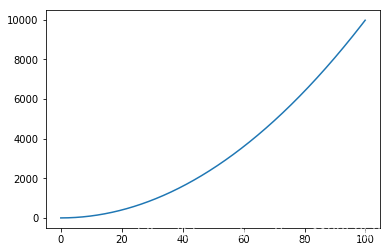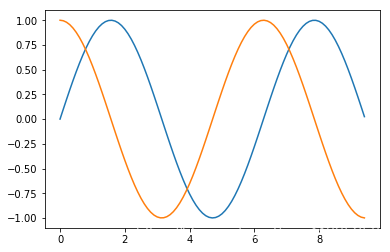import numpy as np
a = [ 4 , 5 , 6 ]
a = np. array( a)
print ( type ( a) )
print ( a. shape)
print ( a[ 0 ] )
< class 'numpy.ndarray' >
( 3 , )
4
b = [ [ 4 , 5 , 6 ] , [ 1 , 2 , 3 ] ]
b = np. array( b)
print ( b. shape)
print ( b[ 0 ] [ 0 ] , b[ 0 ] [ 1 ] , b[ 1 ] [ 1 ] )
( 2 , 3 )
4 5 2
a = np. zeros( [ 3 , 3 ] , dtype= int )
b = np. ones( [ 4 , 5 ] )
c = np. eye( 4 )
d = np. random. rand( 3 , 2 )
a = [ [ 1 , 2 , 3 , 4 ] , [ 5 , 6 , 7 , 8 ] , [ 9 , 10 , 11 , 12 ] ]
a = np. array( a)
print ( a)
print ( a[ 2 , 3 ] , a[ 0 ] [ 0 ] )
[ [ 1 2 3 4 ]
[ 5 6 7 8 ]
[ 9 10 11 12 ] ]
12 1
b = a[ 0 : 2 , : ]
b = b[ : , 2 : 4 ]
print ( b)
print ( b[ 0 ] [ 0 ] )
[ [ 3 4 ]
[ 7 8 ] ]
3
c = a[ - 2 : , : ]
print ( c)
print ( c[ 0 ] [ - 1 ] )
[ [ 5 6 7 8 ]
[ 9 10 11 12 ] ]
8
a = [ [ 1 , 2 ] , [ 3 , 4 ] , [ 5 , 6 ] ]
a = np. array( a)
print ( a[ [ 0 , 1 , 2 ] , [ 0 , 1 , 0 ] ] )
[ 1 4 5 ]
a = [ [ 1 , 2 , 3 ] , [ 4 , 5 , 6 ] , [ 7 , 8 , 9 ] , [ 10 , 11 , 12 ] ]
a = np. array( a)
b = np. array( [ 0 , 2 , 0 , 1 ] )
print ( a[ np. arange( 4 ) , b] )
[ 1 6 7 11 ]
a[ np. arange( 4 ) , b] += 10
print ( a)
[ [ 11 2 3 ]
[ 4 5 16 ]
[ 17 8 9 ]
[ 10 21 12 ] ]
x = np. array( [ 1 , 2 ] )
print ( x. dtype)
int32
x = np. array( [ 1.0 , 2.0 ] )
print ( type ( x) )
< class 'numpy.ndarray' >
x = np. array( [ [ 1 , 2 ] , [ 3 , 4 ] ] , dtype= np. float64)
y = np. array( [ [ 5 , 6 ] , [ 7 , 8 ] ] , dtype= np. float64)
print ( x+ y)
print ( np. add( x, y) )
[ [ 6 . 8 . ]
[ 10 . 12 . ] ]
[ [ 6 . 8 . ]
[ 10 . 12 . ] ]
x, y
print ( x- y)
print ( np. subtract( x, y) )
[ [ - 4 . - 4 . ]
[ - 4 . - 4 . ] ]
[ [ - 4 . - 4 . ]
[ - 4 . - 4 . ] ]
print ( x* y)
print ( np. multiply( x, y) )
print ( np. dot( x, y) )
[ [ 5 . 12 . ]
[ 21 . 32 . ] ]
[ [ 5 . 12 . ]
[ 21 . 32 . ] ]
[ [ 19 . 22 . ]
[ 43 . 50 . ] ]
print ( np. divide( x, y) )
[ [ 0.2 0.33333333 ]
[ 0.42857143 0.5 ] ]
print ( np. sqrt( x) )
[ [ 1 . 1.41421356 ]
[ 1.73205081 2 . ] ]
print ( x. dot( y) )
print ( np. dot( x, y) )
[ [ 19 . 22 . ]
[ 43 . 50 . ] ]
[ [ 19 . 22 . ]
[ 43 . 50 . ] ]
print ( np. sum ( x) )
print ( np. sum ( x, axis= 0 ) )
print ( np. sum ( x, axis= 1 ) )
10.0
[ 4 . 6 . ]
[ 3 . 7 . ]
print ( np. mean( x) )
print ( np. mean( x, axis= 0 ) )
print ( np. mean( x, axis= 1 ) )
2.5
[ 2 . 3 . ]
[ 1.5 3.5 ]
print ( x. T)
[ [ 1 . 3 . ]
[ 2 . 4 . ] ]
print ( np. exp( x) )
[ [ 2.71828183 7.3890561 ]
[ 20.08553692 54.59815003 ] ]
print ( np. argmax( x) )
print ( np. argmax( x, axis= 0 ) )
print ( np. argmax( x, axis= 1 ) )
3
[ 1 1 ]
[ 1 1 ]
import matplotlib. pyplot as plt
x = np. arange( 0 , 100 , 0.1 )
y = x * x
plt. plot( x, y)
x = np. arange( 0 , 3 * np. pi, 0.1 )
y1 = np. sin( x)
y2 = np. cos( x)
plt. plot( x, y1)
plt. plot( x, y2)







 这篇博客详细介绍了numpy库中数组的操作,包括创建一维和二维数组,访问元素,以及各种数学运算,如加减乘除、开方、矩阵转置等。此外,还展示了如何使用matplotlib库进行简单的图形绘制,如平方函数和正弦、余弦函数的曲线图。
这篇博客详细介绍了numpy库中数组的操作,包括创建一维和二维数组,访问元素,以及各种数学运算,如加减乘除、开方、矩阵转置等。此外,还展示了如何使用matplotlib库进行简单的图形绘制,如平方函数和正弦、余弦函数的曲线图。

















 被折叠的 条评论
为什么被折叠?
被折叠的 条评论
为什么被折叠?








